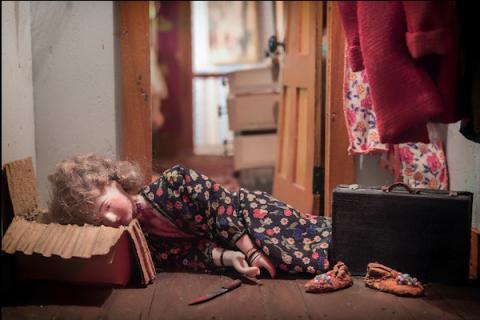The Art of Frances Glessner Lee: Shrinking Evil

“A small thing may give an analogy of great things, and show the tracks of knowledge.”
Lucretius, De Rerum Natura
Why do miniatures enthrall us?
A snow globe is a world within a world. Gazing inside, you see the whole universe at once. Shrinking it to fit in the palm of your hand confers an almighty power. You can shake the globe and make it snow!
Want to make a boy the master of the universe? Give him a model trainset. When he grows up, he can don an engineer’s cap and fill his basement with tracks and switches and stations. Locomotives will chug over tiny bridges, through tunnels, up hills and down valleys into villages. And his trains will run on time.
I never had a dollhouse, but I did have a miniature battery-powered oven that came with tiny baking tins and boxes of cake mix. Both prepared girls for the “women’s work” of running a full-scale household. But dollhouses are also intimate. Regardless of their pedagogical role, they’ve always been spaces in which we are meant to feel safe.
In the 1940s, a Chicago heiress turned the notion of a dollhouse on its head. Tapping into the power and intimacy of miniature dwellings, Frances Glessner Lee constructed 18 tiny scenes of violent death set in rooming houses, rustic cabins, garages, attics—even a nursery. Lee’s crime scene dioramas may be a trifle outdated, but time has not robbed them of any of their power.
Lee was born in 1878. With a fortune from International Harvester, her parents were prominent members of Chicago’s turn-of-the-century social and civic elite. The granite fortress they built on Prairie Avenue had no lawn and few windows facing the street; the basement ones were barred. As wedding gifts, Lee’s parents built her and her brother identical townhouses down the street from each other.

Lee was shy and brilliant. She longed to study nursing or medicine, but her parents sent her brother to Harvard instead. Her mother and aunts tutored her at home in metalwork, sewing and domestic arts. At age twenty, Lee was forced into a society marriage from which she fled, returned, and fled again.
Lee’s interest in crime was spurred by her brother’s Harvard classmate, George Burgess Magrath. A medical examiner, Magrath regaled Lee with stories of real murders and became a lifelong friend. Through him, she finally found her purpose: transforming dollhouses into miniature crime scenes to train homicide investigators.
Lee designed and built her models to exacting standards of realism on a scale of one inch to one foot. All but one of her “nutshells” (she never called them dollhouses) is a dwelling. She drew her crimes from real cases, wrote witness statements, inserted tantalizing clues that sometimes led nowhere, and added tiny victims. Like the snow globe, shrinking her crimes into self-contained universes created the illusion that all the answers were in front of you.
In their tidy little home, a family lies gruesomely slain. The parents are in their bedroom, blood is spattered on the wall behind their baby’s crib, and the kitchen table is set for breakfast. The murder weapon, a rifle, lies on the floor by the table, and the phone is off the hook. But the doors are locked from inside.
In a seamy rooming house, a woman is face-up in the bathtub with water from the faucet pouring onto her head. She had a history of seizures. Did she fall in, or was she drowned by one of the men who’d visited her the night before?
A spinster hangs from a rafter, with old letters and articles of her past strewn at her feet. But her face is bruised and scratched, and why is one of her shoes lying on the attic’s step?

Harvard still uses Frances Glessner Lee’s nutshells in forensic seminars. As a training tool, they endure for what they make us do: observe minute details and convert them to clues, imbue tiny victims with real lives and troubling deaths, and create narratives as to who, how and why. But their lasting impact is greater.
By depicting murder in domestic settings and shrinking it to a 1:12 scale, Lee used the power of miniatures to amplify crime’s human dimensions. Miniaturizing savagery and rage creates an existential dread, and inviting us to peer through windows and behind doors at violence in intimate spaces makes crime personal. The new narrative Lee created is the age-old quest to understand the impossible.
She didn’t want us to gape at evil. She wanted us to make it make sense.
Author Bio:
Stephanie Kane is the author of Object Lessons.
For Highbrow Magazine
Image Sources:
Laurie Shaull (Flickr, Creative Commons)
Laurie Shaull (Wikimedia, Creative Commons)
Laurie Shaull (Flickr, Creative Commons)































































































































































































































































































































